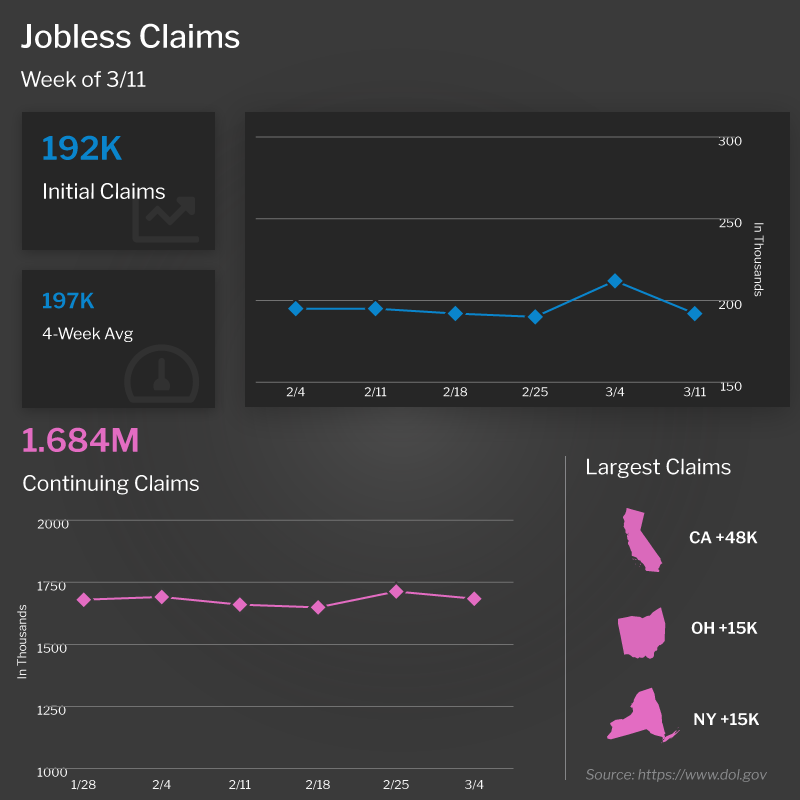Week of March 13, 2023 in Review
Turbulence in the banking sector led to market volatility while news on inflation and home builder confidence brought encouraging signs. Read on for these stories and more:
-
Lag in Shelter Costs Impacting Consumer Inflation
-
Wholesale Inflation Cooler Than Expected
-
Will Cracks in the Banking System Impact Further Fed Rate Hikes?
-
More “Starts” Needed for Single-family Homes
-
Builder Confidence Rose for Third Consecutive Month
-
Unemployment Claims Suggest Slower Pace of Hiring
-
Weakness in Manufacturing and Retail Sales
Lag in Shelter Costs Impacting Consumer Inflation
Consumer inflation was generally in line with forecasts last month, per the latest Consumer Price Index (CPI). Overall, inflation rose 0.4% in February, with the annual reading declining from 6.4% to 6.0%. Core CPI, which strips out volatile food and energy prices, increased 0.5% while the year-over-year index decreased from 5.6% to 5.5%.
What’s the bottom line? The shelter index increased 8.1% over the last year, which accounted for over 60% of the total increase in all items less food and energy per the Bureau of Labor Statistics. However, shelter costs have been coming down in more real-time data. For example, Apartment List’s latest Rent Report showed that year-over-year rent growth decelerated to 3% in February, the lowest level since April 2021. Once these moderating shelter costs are reflected in the CPI data, they should add additional downside pressure to inflation.
And while inflation remains elevated, it has declined one-third from the high of 9.1% seen last June. Since lower inflation typically helps both Mortgage Bonds and mortgage rates improve, these signs of easing inflation are welcome.
Wholesale Inflation Cooler Than Expected
The Producer Price Index (PPI), which measures inflation on the wholesale level, decreased by 0.1% in February, coming in cooler than the 0.3% gain expected. January’s reading was also revised lower. On a year-over-year basis, PPI decreased from a downwardly revised 5.7% to 4.6%. Core PPI, which strips out volatile food and energy prices, was flat last month and much lower than the expected 0.4% gain. On an annual basis, Core PPI declined from 5.4% to 4.4%.
What’s the bottom line? Annual wholesale inflation readings are also moving lower in the right direction, and the progress made on the producer side of inflation is notable. At its peak last March, PPI was at 11.6% year over year and is now well less than half that amount at 4.6%.
Will Cracks in the Banking System Impact Further Fed Rate Hikes?
The markets were especially volatile last week as turbulence in the banking sector was seen here in the U.S. as well as Europe. Part of the issue stems from central banks hiking rates so quickly in such a short period of time, which impacts banks’ interest margins and can lead to liquidity issues, especially if depositors drain their money from banks to take advantage of other higher-yielding options.
What’s the bottom line? This Wednesday brings a crucial decision from the Fed, as they will announce whether they will again hike their benchmark Fed Funds Rate. This is the interest rate for overnight borrowing for banks and it is not the same as mortgage rates. The Fed has hiked the Fed Funds Rate eight times since last March, bringing it to a range of 4.5% to 4.75%.
When the Fed hikes the Fed Funds Rate, they are trying to slow the economy and curb inflation, which continues to ease per the latest CPI and PPI reports as noted above. Will the Fed pause additional hikes to avoid adding more pressure to the banking sector? Their actions and commentary will be crucial to watch in the week ahead.
More “Starts” Needed for Single-family Homes

Home construction picked up in February as Housing Starts, which measure the start of construction on homes, rose 9.8% from January. Building Permits, which are indicative of future supply, also rose 13.8%. While these overall numbers were higher, most of the growth was in multi-family units. Starts for single-family homes were up just 1.1% for the month but they’re still almost 32% lower than they were in February of last year. Permits for single-family homes were also nearly 36% lower than last February.
What’s the bottom line? Single-family homes remain in high demand among buyers and the ongoing disparity between supply and demand should continue to be supportive of prices, especially when we see more hibernating buyers resume their home search. The dynamics in today’s market are very different from the housing bubble, where demand was waning but the supply of new homes was significantly increasing.
Builder Confidence Rose for Third Consecutive Month

The National Association of Home Builders (NAHB) Housing Market Index, which is a near real-time read on builder confidence, rose two points to 44 in March. Among the components of the index, current sales conditions rose two points to 49 while buyer traffic was up three points to 31, marking the strongest traffic reading since last September. Sales expectations for the next six months ticked a point lower to 47.
What’s the bottom line? Overall, home builder confidence has now risen 13 points since the low of 31 in December. Even though the reading is below 50, which signals contraction territory, sentiment is clearly rebounding and moving in the right direction.
Unemployment Claims Suggest Slower Pace of Hiring

Initial Jobless Claims fell by 20,000 in the latest week, with 192,000 people filing for unemployment benefits for the first time. The number of people continuing to receive benefits after their initial claim is filed declined by 29,000 to 1.684 million, which is just below the highest Continuing Claims reading in 14 months.
What’s the bottom line? Initial Jobless Claims remain muted, reflecting a tight labor market where companies are doing their best to hold on to workers. And while Continuing Claims can be volatile from week to week, the overall trend has been higher, as they have now risen by more than 300,000 since the low reached last September. This suggests it’s also harder for people who are let go to find new employment.
Weakness in Manufacturing and Retail Sales
March brought more negative readings (which signal contraction) reported for manufacturing in the New York and Philadelphia regions. The Empire State Index contracted sharply to -24.6, which was much worse than estimates, while the Philadelphia Fed Index remained in contraction territory for the seventh straight month. These reports suggest that the manufacturing sector is already experiencing recession-like conditions.
Meanwhile, Retail Sales were also down 0.4% in February after warmer than expected weather in January boosted sales at the start of the year. A drop in car sales and spending at restaurants contributed to the overall decline last month.
Family Hack of the Week
March Madness is in full swing. This Homemade Salsa recipe courtesy of the Food Network is sure to score big points with your family and friends.
In a bowl, combine 6 Roma tomatoes (chopped), 2 seeded and minced jalapenos, 2 roasted and skinned jalapenos (chopped), 1 red bell pepper (finely diced), 1/2 red onion (finely chopped), 2 dry ancho chiles (seeded and cut into short strips), 1 tablespoon olive oil and 1 lime (juiced). Add salt, pepper and chili powder to taste. Top with fresh cilantro or parsley.
Refrigerate for up to 12 hours so flavors infuse. Enjoy with your favorite tortilla chips.
What to Look for This Week
The Fed’s crucial two-day meeting begins Tuesday, with the Monetary Policy Statement and press conference coming on Wednesday. Housing news will also be in the spotlight, with February’s Existing Home Sales and New Home Sales releasing on Tuesday and Thursday, respectively. The latest Jobless Claims will also be reported on Thursday as usual.
Technical Picture
Mortgage Bonds moved sharply higher Friday, breaking above both their 50-day Moving Average and the 100.758 Fibonacci ceiling. The 10-year moved down to around 3.44%, closing beneath their 200-day Moving Average.

